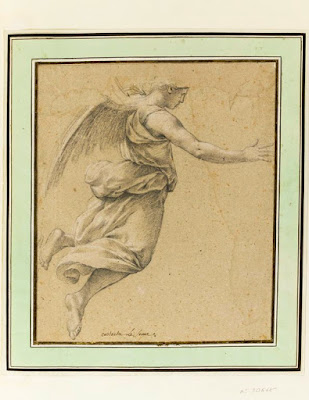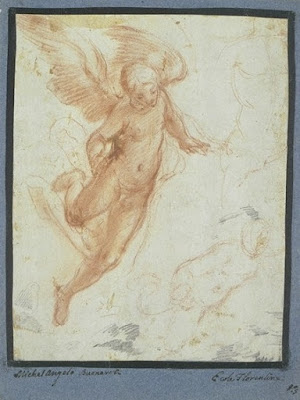 |
| attributed to Simon Vouet Angel before 1649 drawing Musée du Louvre |
 |
| Louis Boullogne the Younger Archangel Gabriel before 1733 drawing (study for painting, The Annunciation) Musée du Louvre |
 |
| Charles Le Brun Flying Angel ca. 1670 drawing (study for painting, Hagar in the Desert) Musée du Louvre |
 |
| Eustache Le Sueur Study for Angel ca. 1645-48 drawing (study for fresco cycle, The Life of St Bruno) Musée du Louvre |
 |
| Augustin Pajou Two Flying Angels ca. 1752-56 drawing Princeton University Art Museum |
 |
| Pierre Mignard Two Flying Angels before 1695 drawing Musée du Louvre |
 |
| attributed to Pierre Mignard Angel ca. 1675 drawing Musée du Louvre |
 |
| Parmigianino Study for Angels supporting Clouds ca. 1522 drawing Musée du Louvre |
 |
| Giuseppe Passeri Design for Ceiling Decoration with Angels before 1714 drawing Musée du Louvre |
 |
| Bernardino Gatti Angels Reading ca. 1576 drawing (study for fresco) Musée du Louvre |
 |
| Anthonie Blocklandt Choir of Angels ca. 1579 drawing (study for painting, The Assumption of the Virgin) Musée du Louvre |
 |
| Nicolò dell'Abate Angel carrying the Cross ca. 1552-58 drawing Musée du Louvre |
 |
| attributed to Cherubino Alberti Study for Angel ca. 1590 drawing Musée du Louvre |
 |
| Alessandro Casolani Study for Angel ca. 1580-1600 drawing Musée du Louvre |
 |
| Cavaliere d'Arpino (Giuseppe Cesari) Angel within Acanthus Border before 1640 drawing Musée du Louvre |
 |
| Pieter de Witte (Pietro Candido) Angel above Gesturing Torso ca. 1614-15 drawing Musée du Louvre |
"One should therefore represent angels as youthful, between the age of 10 and 20 years, which is the median age and corresponds, according to Saint Denis, to the force and vital power that remains ever constant in the angels, youthful beardless beings with beautiful and pleasing faces, with lively and shining eyes – although the virile gaze, the abundant and shining hair, fair or chestnut in hue, alluring and well-proportioned, is itself an external sign of the beauty of their souls, as Saint Augustine says of the appearance of the Archangel Gabriel when he attends upon the Most Holy Virgin. In the Old and New Testaments the angels also most commonly show themselves under the aspect of young men of suchlike age and comely presence. . . . Ordinarily one should paint angels with magnificent wings, diversely coloured in imitation of nature, not so much because God has created them thus but rather to convey their essentially ethereal character, the agility and speed with which they are endowed, the manner in which they may swoop down from the heavens quite unburdened with corporeal weight, their spirits ever concentrated upon God, moving amongst the clouds because the heavens are indeed their proper abode and from whence they may gently communicate to us that inaccessible light in which they rejoice."
– Francisco Pacheco, from The Art of Painting: its Antiquity and Greatness (1649), translated by Nicholas Walker